Mastering Zero Click Search in 2025: What It Is & How to Rank Without Clicks
Table of Contents

In 2025, zero click search has become the silent disruptor of SEO. It refers to search results where audiences get the answer directly on Google, without visiting any website. Think featured snippets, People Also Ask boxes, knowledge panels, Google Maps, and now, the rapidly expanding AI Overviews powered by Google SGE.
Why does this matter? Because more than 65% of Google searches now end without a click. With platforms like Perplexity AI and Bing Copilot adopting similar behaviors, traditional SEO tactics alone aren’t enough. To win visibility today, your content needs to be designed for discovery—not just ranking.
In this guide, you’ll learn how to optimize content for AI-driven search and dominate zero click SERPs using actionable, beginner-friendly strategies built on Bain’s strategic insights—so your brand shows up even when users don’t click.
What is a Zero Click Search?
Zero-click searches happen when Google displays the full answer directly on the search results page (SERP), allowing users to get the information they need without clicking through to any website.
These types of results are powered by rich SERP features that deliver immediate answers. While they improve user experience, they also divert clicks away from websites, making it critical for SEO strategies to shift from simply ranking to gaining search presence.
For example, if you search “What is zero click search?”—Google may show a snippet or an AI Overview right at the top, answering your question instantly.
Google search example displaying direct answer and profile info in SERP without external site visit.
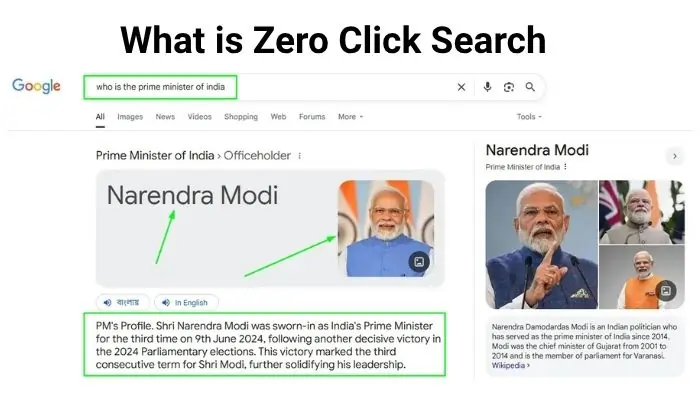
What Types of SERP Features Cause Zero Click Results?
In 2025, over 60% of Google searches result in zero clicks (Similarweb, Bain). This shift is driven by AI and rich SERP features that answer queries instantly—no clicks needed.
Key zero-click features:
- AI Overviews (SGE): AI-generated summaries directly within Google’s search results
- Featured Snippets: Answer boxes are shown above all results
- People Also Ask (PAA): Expandable FAQs with direct responses
- Knowledge Panels: Sidebar summaries for brands and entities
- Local Packs: Displays Google Map Listing, nearby businesses, reviews, and contact info without clicking.
- Weather, Sports, Flights: Real-time information shown directly on the SERP.
- Image/Video Carousels: Visual responses for how-tos or products
👉 To stay visible, format content with clear headings, structured data, and semantic keywords. Optimize for visibility, not just CTR.
Is It Possible to Rank Higher Without Clicks from Google?
Absolutely. In the world of zero-click searches, SEO success is no longer tied to traffic alone. Google’s AI Overviews, featured snippets, Bing Copilot, and tools like Perplexity AI now answer queries directly in the SERP. That means brands can earn top-of-SERP visibility without a single click. This shift has elevated the importance of zero-click SEO, where impressions, engagement signals, and search presence matter more than traditional click-throughs.
To optimize for this new reality:
- Identify and target zero-click keywords with informational or intent-based queries
- Craft short, focused summaries (between 40 and 60 words) that are tailored for both featured snippets and Google’s AI Overviews.
- Implement structured data using schema types like FAQPage, HowTo, and Article
- Use semantic keywords and natural language answers to match user intent
- Build authority with brand mentions and E.E.A.T.-friendly content
- Monitor Google Search Console for tracking search impressions, featured snippets & AI overview data
- Use Google Analytics 4 to track engagement metrics like scroll depth and dwell time
- Analyze on-page behavior with heatmaps (e.g., Hotjar)
- Audit your content for AI summarization structure, not just rankings
Yes, you can rank higher without getting clicks—as long as your SEO strategy shifts from just traffic to visibility, authority, and relevance.
Why Are Zero Click Searches Increasing in 2025?
In 2025, zero click searches are rising faster than ever—driven by AI Overviews, Bing Copilot, and tools like Perplexity AI that deliver instant, rich answers without ever clicking through to a website. According to Similarweb and Bain, over 60% of searches now end without a click, shifting how SEO professionals must approach visibility.
The surge is tied to evolving searcher behavior: users expect answers immediately, especially on mobile devices and through voice search. Google’s Search Generative Experience (SGE) now delivers conversational summaries that eliminate the need to scroll.
Zero-click searches occur when users get answers directly on Google’s results page without clicking on any website. The chart shows zero-click rate trends from 2020 to 2025.
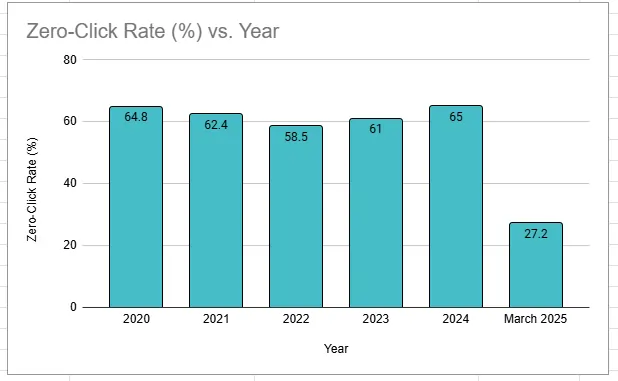
To adapt, SEOs must optimize for featured snippets, structure content for AI-powered results, and target questions users ask in natural language. Emphasize fast-loading pages, schema markup, and answer-first formatting.
How Does Zero Click Search Impact SEO Strategies?
In 2025, zero click search forces SEOs to pivot from traditional click-through rate (CTR) optimization toward visibility optimization. Google’s AI Overviews, featured snippets, and tools like Perplexity now deliver instant answers, making it vital for your brand to appear, even if users never click.
To stay competitive, prioritize E-E-A-T (Experience, Expertise, Authoritativeness, and Trustworthiness). Create content that directly answers questions in the first 100 words, use schema markup to signal credibility, and build topical clusters to reinforce authority.
Step-by-step:
- Identify question-based keywords using tools like AlsoAsked or AnswerThePublic.
- Structure content using FAQs and “People Also Ask” formatting.
- Add author bios, publication dates, and expert quotes.
- Use internal linking to strengthen content silos.
SEO success today isn’t just about driving traffic; it’s about building visibility, earning trust, and positioning your content as the go-to answer.
How Do I Optimize Content for Zero-Click Searches?
Zero-click searches demand a shift in how we craft content. Instead of aiming solely for clicks, the goal is to provide instant, valuable answers directly within the search results. Below are proven techniques to optimize your content for visibility, even when users don’t visit your site.
- Use Q&A Format: Structure your blog with question-based H2s (e.g., “What is zero click search?”).
Example: Neil Patel uses this in his zero-click SEO guide to target featured snippets. - Write Clear Headers/Subheaders: Keep them concise and keyword-rich using terms like AI search, Google SGE, etc.
- Summarize Early: Deliver direct answers in the first 1–2 sentences of each section.
- Add Stats & Definitions: Include facts like “60% of Google searches are zero-click” (Similarweb, Bain).
- Use Internal Linking: Connect related articles to build topical authority and reduce bounce rate.
- Implement Schema Markup: Use FAQs or HowTo schema to boost visibility on AI-driven SERPs.
Can I Still Get Traffic from Zero Click Results?
Absolutely. Even when users don’t click, smart SEO keeps your brand top-of-mind and drives future actions. Here’s how:
- Leverage Branded Snippets: Format answers that feature your brand name or tagline in the snippet itself.
Example: Ahrefs often ranks for “what is domain rating,” and their brand appears directly in the featured snippet—building authority even without a click. - Optimize for Navigational Searches: Use your brand and product names in titles, headers, and meta descriptions.
- Boost Topical Authority: Create multiple high-quality cluster pages around your niche.
- Embed Soft CTAs: Include subtle calls to action in the first 100 words (e.g., “See our full guide for examples”).
- Retarget Zero-Click Visitors: Use paid ads and pixels to retarget users who saw your content but didn’t click.
- Build Brand Familiarity: The more users recognize your brand in snippets, the more likely they’ll return via direct or branded search.
What is Google AI Overview and How Is It Related to Zero Click Search?
- Google’s AI Overview leverages generative AI technology to present summarized answers right on the search page—often reducing the need for users to click on a website.
- This shift fuels the rise in zero-click searches, where users get answers instantly.
- Platforms like Bing Copilot and Perplexity AI follow similar models, emphasizing quick, AI-generated summaries.
- To earn visibility, structure your content with clear headings, concise answers, and an FAQ or How-To schema.
- Use semantic keywords like AI search summaries, zero-click SEO, and SGE optimization in the first 100 words.
- Example: Healthline ranks in AI summaries due to expert-backed content and strong topical structure.
Which schema markup helps with zero click search visibility?
Search engines reward structured data. Implementing schema markups enhances how your content appears in AI-driven search results like Google’s AI Overviews and Perplexity’s answers.
According to Similarweb, zero-click searches now make up 60% of all queries, and Perplexity’s user behavior data reveals an increasing trend of no-click informational queries. To win visibility, use:
- FAQPage: Ideal for question-based content (use on FAQ sections).
- HowTo: Works for step-by-step tutorials and guides.
- Article: Helps blog and news posts show rich info.
- Product / LocalBusiness: Boosts visibility in shopping and local packs.
Sample JSON-LD:
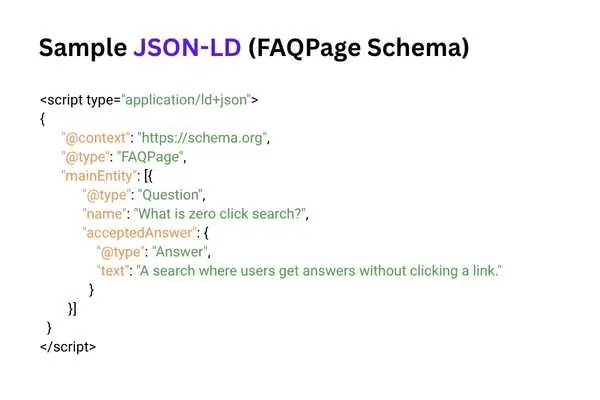
How Do I Track Zero-Click Impressions and Performance?
As zero click search reshapes SEO through AI Overviews, Bing Copilot, and Perplexity, visibility—not just clicks—has become the key metric. Tracking performance means focusing on engagement signals and on-SERP presence.
- Google Search Console: Track Impressions vs. CTR for visibility insights.
- Monitor featured snippets and AI Overview placements across search platforms.
- In Google Analytics 4, analyze scroll depth, engagement rate, and dwell time.
- Use heatmaps (e.g., Hotjar) to understand on-page user behavior.
- Check Bing Webmaster Tools for AI-powered search appearance data.
- Use log file analysis to identify AI bot activity and spot patterns related to zero-click data retrieval from your site
Real-world example: A SaaS brand boosted branded searches by 38% after optimizing for snippets and improving engagement metrics.
Stat: (e.g., “70% of users never scroll past the first result” – Backlinko) to reinforce the urgency of optimizing for visibility.
What tools help monitor and optimize for zero click search SEO?
To stay competitive in the zero click search landscape, you need tools that uncover insights beyond just rankings. Below is a comparison of essential tools that help track impressions, AI Overview visibility, SERP features, and user behavior metrics:
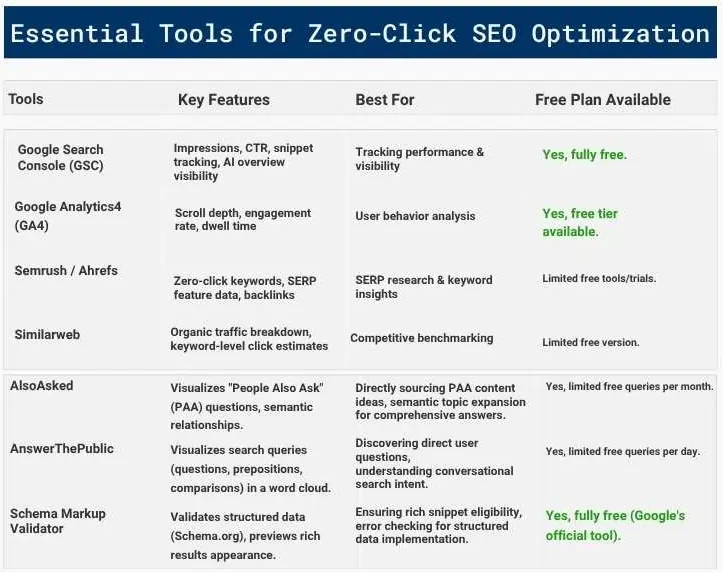
Checklist: Zero-Click SEO in the AI Era
Mastering zero-click SEO today means adapting to AI-driven search and shifting from clicks to visibility. Here’s your action plan to stay ahead:
- Optimize for featured snippets, AI Overviews, and People Also Ask
- Use schema markup (FAQs, How To, ..) to enhance rich results
- Track impressions vs. click-through-rate and engagement signals in GSC and GA4
- Monitor tools like SEMrush, Also Asked, and Bing Webmaster Tools
- Implement internal linking and topical clusters to strengthen authority
Zero-click doesn’t mean zero opportunity—it means visibility-first SEO.
Download the full Zero-Click SEO Checklist
Frequently Asked Questions
FAQs (Frequently Asked Questions) refer to a curated list of common questions and answers related to a specific topic, product, or service. They help users quickly find relevant information, improve website navigation, and enhance SEO by targeting long-tail keywords and addressing user search intent.
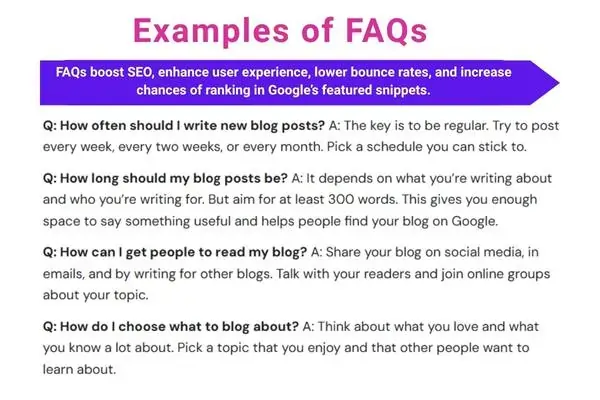
FAQs
1. What's Next for the Future of Zero Click Search?

Zero click search is evolving fast with AI overviews, voice assistants, and smart SERPs. For marketers, the focus must shift from traffic to visibility. Mastering structured data, building topical authority, and crafting content for user intent will be key to staying ahead in this AI-first search landscape.
2. What is the difference between a zero click search and a regular organic click?
A regular organic click sends users to your site, while a zero click search provides answers directly on the SERP—meaning no visit, just exposure.
3. Can featured snippets lead to zero click search?

Yes, featured snippets are one of the main causes of zero-click results. However, they still offer branding opportunities and voice search benefits.
4. Do “People Also Ask” (PAA) boxes impact click-through rates?
Yes. PAA boxes can reduce traditional clicks by answering questions immediately, but targeting them can boost your visibility on Page 1.
5. How does mobile-first indexing relate to zero click search behavior?
Since mobile users prefer fast answers, Google’s mobile-first indexing favors content that loads fast and satisfies intent—key factors in zero-click outcomes.
6. How can local SEO benefit from zero click search trends?
Google’s Local Pack is a zero-click SERP feature. Optimizing GMB, NAP, and reviews can help businesses appear in location-based queries without clicks.
7. How do zero-click searches affect bounce rate and user engagement?
While bounce rate may improve due to fewer sessions, user engagement depends on your SERP presence—meaning optimizing metadata and rich snippets is essential.
👉 Read next: AI Overviews SEO Guide